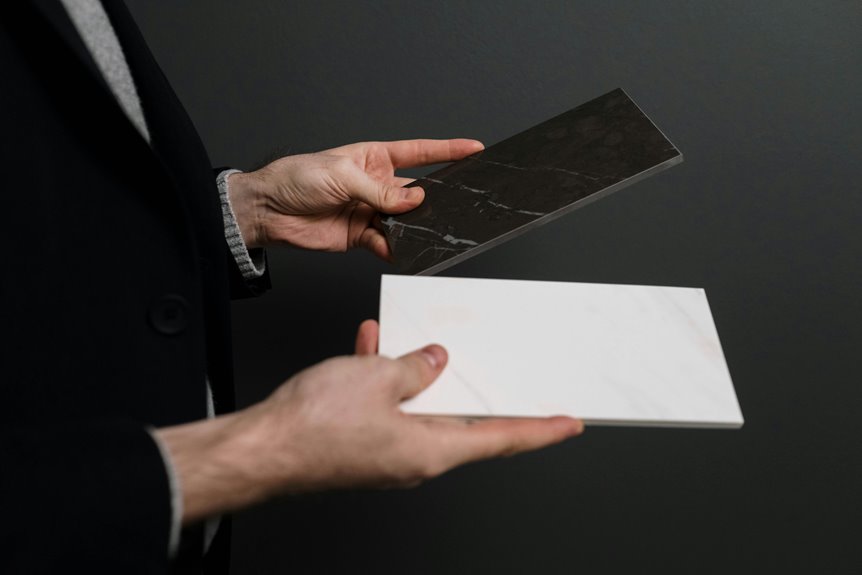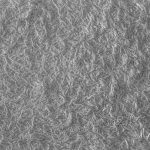Charmeuse and satin both offer a glossy, elegant look, but differ mainly in weight, texture, and durability. Charmeuse is lighter with a softer drape and a subtle glow, perfect for luxe linings or flowing evening wear. Satin is heavier, sturdier, and shinier, making it ideal for structured gowns and accessories. Knowing these differences helps you pick the perfect fabric for comfort, visual effect, and care needs. Keep exploring to understand which suits your next project best.
Table of Contents
Key Takeaways
- Charmeuse is lightweight with a soft, subtle glow and a dull back, while satin is heavier with a brighter shine and glossy front and back.
- Charmeuse has a softer drape ideal for elegant, fluid garments; satin offers more structure and durability for formal wear.
- Satin’s denser weave makes it sturdier and better for accessories and décor; charmeuse requires gentle care due to its delicate nature.
- Choose charmeuse for comfort-focused, high-end linings and evening wear; select satin for polished gowns, bridal wear, and decorative pieces.
- Consider fabric texture, shine preference, care needs, and garment function when deciding between charmeuse and satin for your project.
What Is Charmeuse Fabric?
Charmeuse fabric offers a smooth, glossy surface that feels incredibly soft to the touch. When you run your fingers across it, you’ll notice its fluid drape and lightweight nature, making it perfect for elegant garments.
It’s typically made from silk or synthetic fibers like polyester, giving it that subtle sheen. You’ll find charmeuse used in evening gowns, lingerie, and blouses because it enhances comfort while maintaining a luxurious appearance.
Unlike some fabrics, charmeuse has a distinct shiny front and a dull back, which helps you identify it easily. If you want fabric that moves gracefully and feels gentle on your skin, charmeuse is a great choice you won’t regret.
Its combination of beauty and comfort makes it stand out.
Understanding Satin Fabric
When you explore satin fabric, you’ll notice its unique weave structure that gives it a smooth, glossy surface.
You’ll find satin made from various materials like silk, polyester, and nylon, each affecting its feel and durability.
Understanding these characteristics helps you choose the right satin for your project or wardrobe.
Satin Weave Structure
Although satin is often admired for its smooth, glossy surface, its unique appeal comes from the specific weave structure that creates this luxurious finish.
Unlike other weaves, satin uses a technique that allows long floats of yarn to pass over multiple threads beneath, giving the fabric its characteristic sheen and smooth texture.
When you examine satin weave, keep these key points in mind:
- Float Threads: Satin weaves have more yarn floats on the surface, which reflect light and create the glossy look.
- Weaving Pattern: The pattern skips interlacing points, reducing friction and adding softness.
- Durability: While elegant, the long floats make satin more prone to snagging compared to tighter weaves.
Understanding this helps you appreciate why satin feels and looks so distinct.
Common Satin Materials
The unique weave of satin not only shapes its look and feel but also influences the materials used to create it. You’ll find satin made from various fibers, each offering distinct qualities.
Silk satin, the most luxurious, feels incredibly smooth and drapes beautifully, but it’s pricey and requires delicate care.
Polyester satin is a popular, affordable alternative; it’s durable, wrinkle-resistant, and holds color well, making it practical for everyday wear.
Nylon satin shares similar properties but tends to be lighter and slightly less shiny.
You might also encounter acetate satin, known for its glossy finish and affordability, though it’s less durable.
Understanding these materials helps you choose the right satin for your project, balancing texture, appearance, and maintenance needs effectively.
Satin Fabric Characteristics
Satin stands out for its glossy surface and smooth texture, which come from its unique weaving technique. When you choose satin, you’re getting a fabric that reflects light beautifully, giving it that signature shine. This makes it perfect for elegant garments and luxurious bedding.
To understand satin better, consider these key characteristics:
- Weave Structure: Satin uses a four-over, one-under weave, creating fewer interlacings, which results in its smooth, lustrous face and dull back.
- Durability: Though glossy, satin is relatively strong but can snag easily due to its delicate weave.
- Drape: Satin drapes fluidly, hugging curves gracefully, which is why it’s favored in evening wear and lingerie.
Knowing these traits helps you pick satin confidently for your next project.
Comparing the Weave and Construction
You’ll notice charmeuse and satin both use satin weave patterns, but their construction varies.
Charmeuse typically features a softer, lighter build, while satin can be heavier and more durable.
Understanding these differences helps you choose the right fabric for your project.
Weave Patterns Explained
Although charmeuse and satin might look similar at first glance, their distinct weave patterns set them apart. Understanding these patterns helps you choose the right fabric for your project. Here’s what you need to know:
- Satin Weave: Satin uses a weaving technique where warp threads float over weft threads, creating a glossy surface on one side and a dull back. This results in a smooth, shiny finish typical of satin fabrics.
- Charmeuse Weave: Charmeuse is a type of satin weave but with fewer floats, giving it a softer drape and lighter feel. Its weave creates a lustrous front and a matte back, but it’s generally lighter and silkier.
- Float Length: The length of floating threads affects sheen and texture; longer floats produce more shine but less durability.
Knowing these details helps you pick charmeuse for softness or satin for sheen.
Fabric Construction Differences
When choosing between charmeuse and satin, understanding their fabric construction goes beyond just the weave pattern.
Charmeuse is typically made from silk or synthetic fibers like polyester, woven in a way that creates a lightweight, smooth, and fluid fabric with a lustrous front and a dull back.
Satin, on the other hand, refers more broadly to the weave style rather than the fiber content. Satin can be made from silk, polyester, or nylon and features a denser weave, resulting in a heavier, more structured fabric with a glossy surface.
This difference in fiber type and density affects how the fabric drapes and feels against your skin.
Differences in Appearance and Texture
Since charmeuse and satin often look similar at first glance, you might find it tricky to tell them apart by appearance alone.
However, a closer look reveals key differences in their finish and feel. Here’s what you should notice:
- Sheen: Charmeuse has a soft, subtle glow, while satin shines more brightly, almost mirror-like.
- Texture: Charmeuse feels smooth and silky with a slight weight, giving it a luxurious drape; satin is generally stiffer and slicker to the touch.
- Backside: Charmeuse typically has a dull or matte back, contrasting its glossy front, whereas satin’s back may also have some sheen, depending on the fiber.
Knowing these traits helps you pick the right fabric to match your project’s look and feel perfectly.
Durability and Care Considerations
Understanding durability and care is key to keeping charmeuse and satin looking their best over time. Both fabrics require delicate handling, but charmeuse tends to be more prone to snags, while satin’s weave can show wear faster. Washing both on gentle cycles or hand washing is best, and air drying helps maintain their sheen.
| Aspect | Charmeuse | Satin |
|---|---|---|
| Durability | Lightweight, prone to snags | More robust but shows wear |
| Washing | Hand wash or gentle cycle | Gentle cycle or dry clean |
| Drying | Air dry, avoid direct heat | Air dry preferable |
| Ironing | Low heat, inside out | Low to medium heat, inside out |
Ideal Uses for Charmeuse
Both charmeuse’s delicate nature and its luxurious sheen make it a standout choice for specific applications.
When you want to elevate your project with a soft, flowing fabric that catches the light beautifully, charmeuse is your go-to.
Consider these ideal uses:
- Eveningwear and lingerie – Its smooth, silky texture feels amazing against the skin, perfect for gowns and intimate apparel.
- Blouses and scarves – The drape and shine add elegance and sophistication to casual or formal accessories.
- Linings for high-end garments – Charmeuse provides a smooth finish, enhancing comfort and luxury inside tailored pieces.
When you choose charmeuse, you’re opting for elegance and softness that enhance both comfort and style.
Best Projects for Satin Fabric
Satin’s glossy surface and sturdy weave make it perfect for projects where durability meets elegance.
You’ll find satin ideal for evening gowns and cocktail dresses that require a polished look with some structure. It’s also great for bridal wear, offering a luxurious sheen that holds shape well.
When making accessories like ties, handbags, or headbands, satin adds a sophisticated finish that lasts.
Home décor projects benefit too—think pillow covers or drapes that catch the light beautifully yet stand up to daily use.
If you want a fabric that balances shine with resilience, satin fits the bill.
Just remember, its weight and texture suit pieces needing both visual impact and long-lasting wear.
How to Choose Between Charmeuse and Satin
How do you decide between charmeuse and satin for your next project? Consider the fabric’s feel, appearance, and purpose to make the best choice.
1. Texture and Drape: Charmeuse feels silky and smooth with a fluid drape, perfect for garments needing elegance and softness.
Satin can be heavier with a stiffer drape, ideal for structured pieces.
2. Visual Impact: Charmeuse shines subtly on one side, giving a delicate glow.
Satin often has a more reflective, glossy finish that stands out under light.
3. Functionality and Care: Charmeuse, usually silk, requires gentle handling, while satin (often polyester) is more durable and easier to maintain.
Match your fabric choice to your design’s needs, balancing look, feel, and practicality for a polished final result.
Frequently Asked Questions
Can Charmeuse and Satin Be Dyed the Same Way?
You can dye both charmeuse and satin, but you’ll need to take into account their fiber content. Synthetic satins require special dyes, while natural charmeuse takes color more readily. Always test a small area first for best results.
Are Charmeuse and Satin Fabrics Hypoallergenic?
Think of charmeuse and satin as gentle guardians of your skin; both are usually hypoallergenic, but you should check specific fabric blends. You’ll find them comfortable, but always test if you have sensitive skin or allergies.
Which Fabric Is More Breathable, Charmeuse or Satin?
You’ll find charmeuse more breathable because it’s usually made from silk, letting air flow better. Satin, often polyester, traps heat more, so if you want cooler comfort, charmeuse is the way to go.
Can Charmeuse or Satin Be Used for Upholstery?
You wouldn’t want to put all your eggs in one basket by using charmeuse or satin for upholstery—they’re delicate and prone to wear. Instead, choose sturdier fabrics designed to withstand daily use and spills.
Do Charmeuse and Satin Fabrics Wrinkle Easily?
You’ll find charmeuse wrinkles more easily due to its smooth, delicate weave, while satin tends to resist wrinkles better. Still, both fabrics need gentle care to keep their sleek, shiny appearance without creases.
- Nonwoven Polypropylene: Is It Washable and Reusable? - July 11, 2025
- All About Spunbond Nonwoven Fabric and Its Uses - July 11, 2025
- The Ultimate FAQ on Nonwoven Fabrics - July 11, 2025






